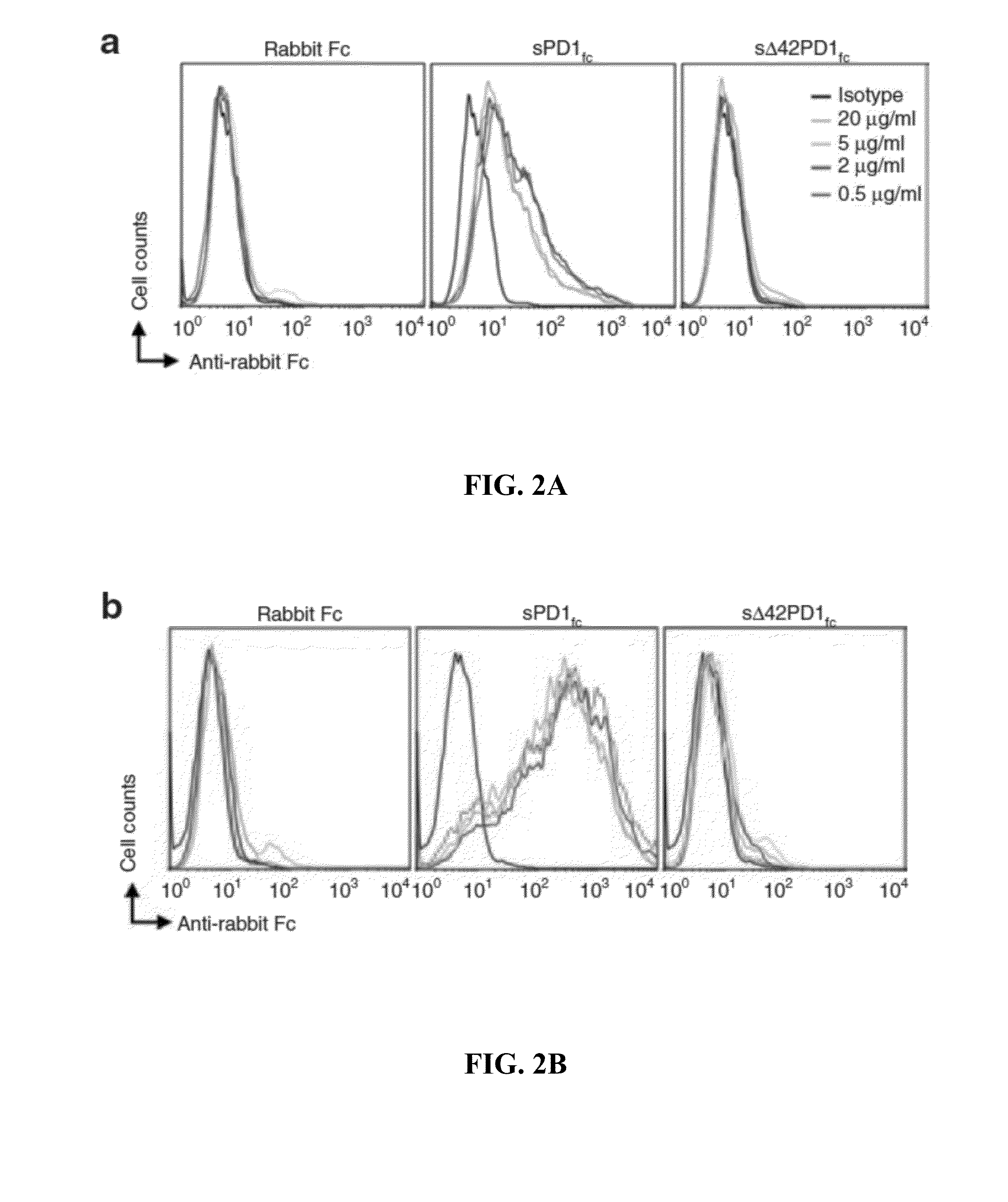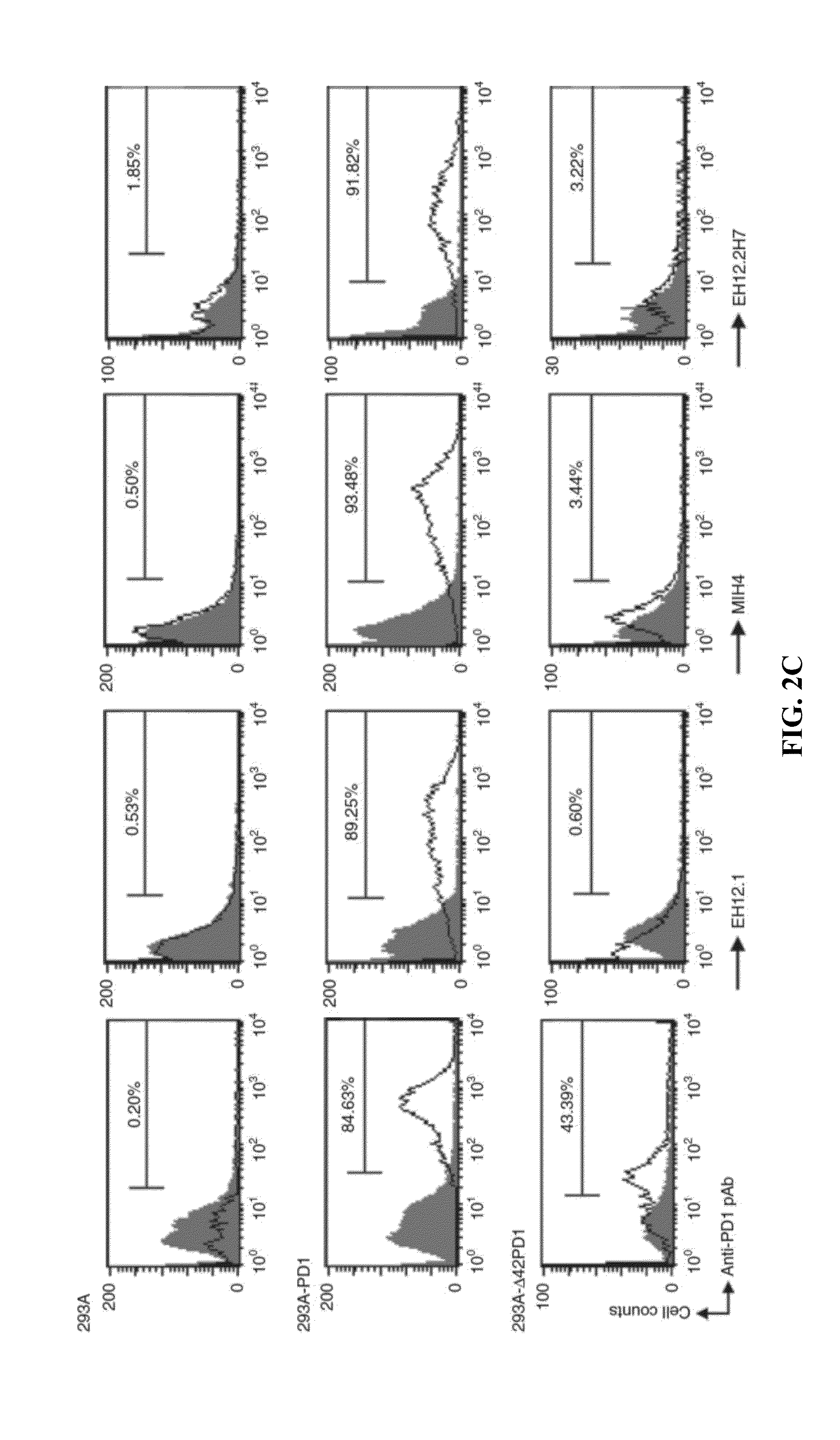Novel pd1 isoforms, and uses thereof for potentiating immune responses
a pd1 isoform and immunomodulatory technology, applied in the field of pd1 isoforms, can solve the problems of inability to control viral replication, poor functionality of hiv-1-specific t cells in patients, and the dysfunction of these t cells, so as to prevent, treat, or improve the effect of pathogenic infection and/or cancer
- Summary
- Abstract
- Description
- Claims
- Application Information
AI Technical Summary
Benefits of technology
Problems solved by technology
Method used
Image
Examples
example 1
Novel PD1 Isoform
[0220]To investigate the polymorphism of PD1 gene, mRNA transcripts from PBMCs from 25 human healthy donors are examined. In one representative donor with seven clones, T-PCR and sequence analysis showed that six clones harbored an identical isoform of PD1, which consists of a 42-base pairs deletion from the start of exon 2 that is equivalent to a 14 amino acid in-frame deletion (DSPDRPWNPPTFFP) (SEQ ID NO:3) (FIGS. 1a,b). The PD1 isoform was as designated as Δ42PD1.
[0221]To verify that this deletion is not due to intrinsic genomic defect from multiple donors, PCR was performed using primers that flank the deleted region. As a control, genomic DNA only detected wildtype PD1 (FIG. 1c, lanes 1-7, lower gel), while both wildtype PD1 and Δ42PD1 transcripts were readily detected from cDNA generated from five out of seven donor PBMCs (FIG. 1c, lanes 1-7, upper gel), which are confirmed by sequence analysis. Hence, this transcript isoform is likely due to alternative splic...
example 2
Δ42PD1 Induces the Production of Pro-Inflammatory Cytokines in Human PBMCS
[0232]This Example investigates the function of Δ42PD1 using the purified sΔ42PD1Fc proteins to treat human PBMCs and measured the production of cytokines.
[0233]Briefly, PBMCs were treated with purified sPD1Fc, sΔ42PD1Fc or rabbit Fc recombinant proteins for 24 h, and supernatants were collected to determine the cytokine release profile by a multiplex assay. Untreated cells or LPS served as negative and positive controls, respectively.
[0234]As shown in FIG. 3a, PBMCs treated with sΔ42PD1Fc had significantly higher levels of TNF-α, IL-6 and IL-1β cytokine production, when compared to sPD1Fc or rabbit Fc. Other cytokines IFN-γ, IL-2, IL-4, IL-5, IL-8, IL-10, IL-12p70 and TNF-β were not detected following treatment by these recombinant proteins (data not shown).
[0235]For verification, quantitative real-time PCR was performed at 6 h, 12 h and 24 h post-treatment of PBMCs, and relative mRNA expression of TNFα, IL6,...
example 3
Δ42PD1 Fused to Antigen Promotes Specific Adaptive Immunity In Vivo
[0241]As TNF-α, IL-6 and IL-1β have cooperative and key roles in the generation of adaptive immunity, this Examples investigates whether Δ42PD1 can perform this function in vivo.
[0242]Briefly, a fusion DNA vaccine construct comprised of HIV-1 Gag p24 is generated for use as the target immunogen with human sΔ42PD1 tagged to rabbit Fc (sΔ42PD1-p24fc; FIG. 12a); DNA encoding p24fc is used as control. The rabbit Fc used only contains the CH2-CH3 domain and thus does not bind to rabbit Fcγ receptor. The tPA-leader was fused with the leader sequence of PD1 to increase protein release, while the signal peptide cleavage of Δ42PD1 remains the same as wildtype PD1. Expression of their encoded protein was confirmed by Western blotting (FIG. 12b).
[0243]The DNA vaccine constructs were delivered at a dose of 20 μg / shot to Balb / c mice intramuscularly (i.m.) with electroporation (EP) according to our previously used immunization reg...
PUM
| Property | Measurement | Unit |
|---|---|---|
| Tm | aaaaa | aaaaa |
| concentration | aaaaa | aaaaa |
| concentration | aaaaa | aaaaa |
Abstract
Description
Claims
Application Information
 Login to View More
Login to View More - R&D
- Intellectual Property
- Life Sciences
- Materials
- Tech Scout
- Unparalleled Data Quality
- Higher Quality Content
- 60% Fewer Hallucinations
Browse by: Latest US Patents, China's latest patents, Technical Efficacy Thesaurus, Application Domain, Technology Topic, Popular Technical Reports.
© 2025 PatSnap. All rights reserved.Legal|Privacy policy|Modern Slavery Act Transparency Statement|Sitemap|About US| Contact US: help@patsnap.com



